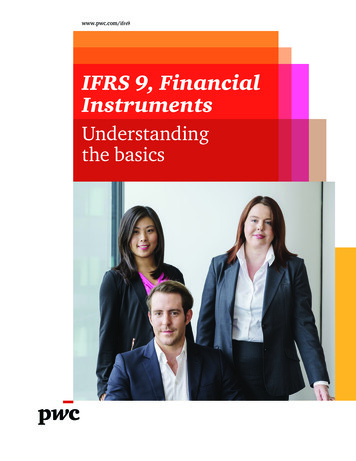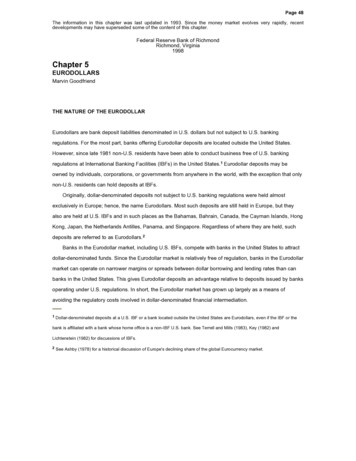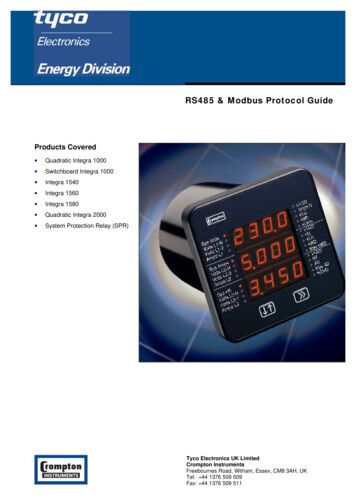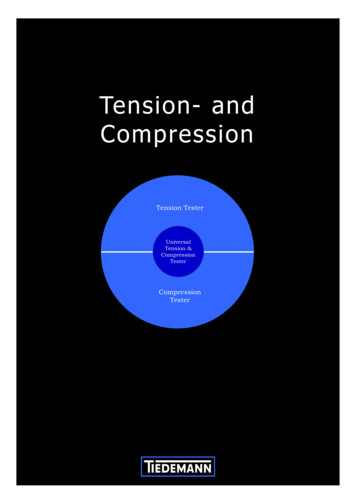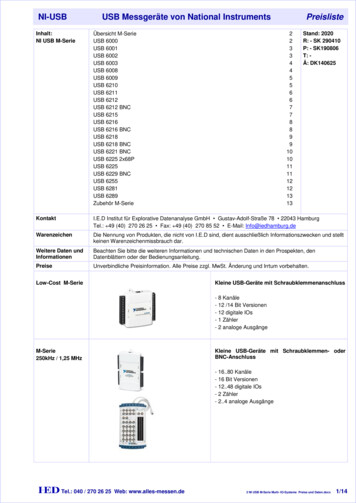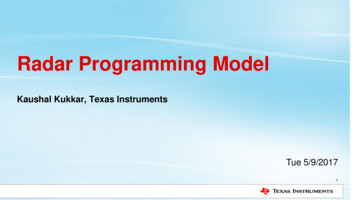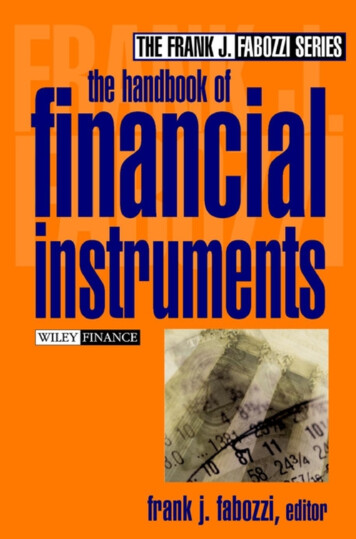
Transcription
The Handbook offinancialinstruments
THE FRANK J. FABOZZI SERIESFixed Income Securities, Second Edition by Frank J. FabozziFocus on Value: A Corporate and Investor Guide to Wealth Creation by James L.Grant and James A. AbateHandbook of Global Fixed Income Calculations by Dragomir KrginManaging a Corporate Bond Portfolio by Leland E. Crabbe and Frank J. FabozziReal Options and Option-Embedded Securities by William T. MooreCapital Budgeting: Theory and Practice by Pamela P. Peterson and Frank J. FabozziThe Exchange-Traded Funds Manual by Gary L. GastineauProfessional Perspectives on Fixed Income Portfolio Management, Volume 3 editedby Frank J. FabozziInvesting in Emerging Fixed Income Markets edited by Frank J. Fabozzi andEfstathia PilarinuHandbook of Alternative Assets by Mark J. P. AnsonThe Exchange-Traded Funds Manual by Gary L. GastineauThe Global Money Marketsby Frank J. Fabozzi, Steven V. Mann, andMoorad Choudhry
The Handbook offinancialinstrumentsFRANK J. FABOZZIEDITORJohn Wiley & Sons, Inc.
Copyright 2002 by Frank J. Fabozzi. All rights reserved.Published by John Wiley & Sons, Inc., Hoboken, New JerseyPublished simultaneously in CanadaNo part of this publication may be reproduced, stored in a retrieval system, or transmitted inany form or by any means, electronic, mechanical, photocopying, recording, scanning, or otherwise, except as permitted under Section 107 or 108 of the 1976 United States CopyrightAct, without either the prior written permission of the Publisher, or authorization throughpayment of the appropriate per-copy fee to the Copyright Clearance Center, Inc., 222 Rosewood Drive, Danvers, MA 01923, 978-750-8400, fax 978-750-4470, or on the web atwww.copyright.com. Requests to the Publisher for permission should be addressed to the Permissions Department, John Wiley & Sons, Inc., 111 River Street, Hoboken, NJ 07030, 201748-6011, fax 201-748-6008, e-mail: permcoordinator@wiley.com.Limit of Liability/Disclaimer of Warranty: While the publisher and author have used their bestefforts in preparing this book, they make no representations or warranties with respect to theaccuracy or completeness of the contents of this book and specifically disclaim any impliedwarranties of merchantability or fitness for a particular purpose. No warranty may be createdor extended by sales representatives or written sales materials. The advice and strategies contained herein may not be suitable for your situation. You should consult with a professionalwhere appropriate. Neither the publisher nor author shall be liable for any loss of profit orany other commercial damages, including but not limited to special, incidental, consequential,or other damages.For general information on our other products and services, or technical support, please contact our Customer Care Department within the United States at 800-762-2974, outside theUnited States at 317-572-3993 or fax 317-572-4002.Wiley also publishes its books in a variety of electronic formats. Some content that appears inprint may not be available in electronic books.ISBN: 0-471-22092-2Printed in the United States of America10 9 8 7 6 5 4 3 2 1
contentsPrefaceContributing AuthorsCHAPTER 1Overview of Financial InstrumentsFrank J. Fabozziixxiii1CHAPTER 2Fundamentals of InvestingFrank J. Fabozzi15CHAPTER 3Calculating Investment ReturnsBruce Feibel35CHAPTER 4Common StockFrank J. Fabozzi, Frank J. Jones, and Robert R. Johnson67CHAPTER 5Sources of Information for Investing in Common StockPamela P. Peterson and Frank J. Fabozzi119CHAPTER 6Money Market InstrumentsFrank J. Fabozzi, Steven V. Mann, and Moorad Choudhry143CHAPTER 7U.S. Treasury SecuritiesFrank J. Fabozzi and Michael J. Fleming185v
viContentsCHAPTER 8Inflation-Indexed BondsJohn B. Brynjolfsson203CHAPTER 9Federal Agency SecuritiesFrank J. Fabozzi and George P. Kegler215CHAPTER 10Municipal SecuritiesFrank J. Fabozzi229CHAPTER 11Corporate BondsFrank J. Fabozzi251CHAPTER 12Preferred StockSteven V. Mann and Frank J. Fabozzi283CHAPTER 13Emerging Markets DebtMaria Mednikov Loucks, John A. Penicook, Jr., and Uwe Schillhorn297CHAPTER 14Agency Mortgage-Backed SecuritiesFrank J. Fabozzi and David Yuen331CHAPTER 15Nonagency MBS and Real Estate-Backed ABSFrank J. Fabozzi amd John Dunlevy367CHAPTER 16Commercial Mortgage-Backed SecuritiesJoseph F. DeMichele, William J. Adams, and Duane C. Hewlett399CHAPTER 17Non-Real Estate Asset-Backed SecuritiesFrank J. Fabozzi and Thomas A. Zimmerman423
ContentsviiCHAPTER 18Credit Card ABSJohn N. McElravey449CHAPTER 19Leveraged LoansSteven Miller469CHAPTER 20Collateralized Debt ObligationsLaurie S. Goodman and Frank J. Fabozzi483CHAPTER 21Investment CompaniesFrank J. Jones and Frank J. Fabozzi503CHAPTER 22Exchange-Traded Funds and Their CompetitorsGary L. Gastineau531CHAPTER 23Stable-Value Pension InvestmentsJohn R. Caswell and Karl P. Tourville555CHAPTER 24Investment-Oriented Life InsuranceFrank J. Jones573CHAPTER 25Hedge FundsMark J. P. Anson605CHAPTER 26Private EquityMark J. P. Anson671CHAPTER 27Real Estate InvestmentSusan Hudson-Wilson697
viiiContentsCHAPTER 28Equity DerivativesBruce M. Collins and Frank J. Fabozzi723CHAPTER 29Interest Rate DerivativesFrank J. Fabozzi and Steven V. Mann755CHAPTER 30Mortgage SwapsDavid Yuen and Frank J. Fabozzi775CHAPTER 31Credit DerivativesMoorad Choudhry785CHAPTER 32Managed FuturesMark J. P. Anson805INDEX825
prefacene of the most important investment decisions that an investorencounters is the allocation of funds among the wide range of financial instruments. That decision requires an understanding of the investment characteristics of all asset classes. The objective of The Handbookof Financial Instruments is to explain financial instruments and theircharacteristics.In Chapter 1, financial assets and financial markets are defined. Alsoexplained in the chapter are the general characteristics of common stockand fixed-income securities, the properties of financial markets, the general principles of valuation, the principles of leverage, mechanisms forborrowing funds in the market using securities as collateral, and the roleof derivative products.Chapter 2 provides the fundamentals of investing. This is done interms of the phases of the investment management process. The topicsincluded in the chapter are traditional and alternative asset classes, howasset classes are determined, various types of risk, active versus passiveportfolio management, and active versus indexed portfolio construction.Chapter 3 explains the proper methodology for computing investment returns. Complications associated with calculating investmentreturns include selection of the appropriate inputs in the calculation,treatment of client contributions and withdrawals from an investmentaccount, the timing of contributions and withdrawals, the differencebetween return earned by the investment manager on the funds investedand the return earned by the client, and how to determine annual returnsfrom subperiod returns (e.g., different methods for averaging).Equity, more popularly referred to as common stock, is the subject ofChapters 4 and 5. Chapter 4 describes the markets where common stockis traded, the types of trades that can be executed by retail and institutional investors (e.g., block trades and program trades), transaction costs,stock market indicators, the pricing efficiency of the equity market, common stock portfolio management, active portfolio management (e.g., topdown versus bottom-up approaches, fundamental versus technical analysis, popular active stock market strategies, and equity style management).Oix
xPrefaceWhere an investor can obtain information about the issuers of commonstock and the type of information available is the subject of Chapter 5.Chapters 6 through 20 cover fixed income products—money marketinstruments, Treasury securities (fixed principal and inflation indexed securities), federal agency securities, municipal securities, corporate bonds, preferred stock, emerging market debt, leveraged loans, and structuredproducts. Structured products covered include agency mortgage-backedsecurities, nonagency mortgage-backed securities, real estate-backed assetbacked securities (e.g., home equity loan-backed securities and manufactured home loan-backed securities), commercial mortgage-backed securities, non-real estate-backed securities (e.g., credit card receivable-backedsecurities, auto loan-backed securities, Small Business Administration loanbacked securities, student loan-backed securities, aircraft lease-backedsecurities, and rate reduction bonds), and collateralized debt obligations.Chapter 21 provides comprehensive coverage of investment companies, more popularly referred to as mutual funds. Topics covered are thetypes of investment companies, fund sales charges and annual operatingexpenses, multiple share classes, types of funds by investment objective,regulation of funds, the advantages and disadvantages of mutual funds,and alternatives to mutual funds. One alternative to a mutual fund is anexchange-traded fund. The advantages of an exchange-traded fund areexplained Chapter 22, which also covers competitor products.Stable value products are covered in Chapter 23. These products provide for a guaranteed return of principal at a contractually specified rate,the guarantee being only as good as the issuer of the contract. Examplesinclude fixed annuities and traditional guaranteed investment contracts(GICs), separate account GICs, and bank investment contracts. Comprehensive coverage of investment-oriented life insurance products is providedin Chapter 24. These products include cash value life insurance (variablelife, universal life, and variable universal life) and annuities (variable, fixed,and GICs). General account versus separate account products and the taxability of life insurance products are also discussed in the chapter.Two major alternative asset classes are hedge funds and privateequity. They are the subject of Chapters 25 and 26, respectively. The coverage of hedge funds includes regulation, strategies employed by hedgefunds (e.g., long/short hedge funds, global macro hedge fund, short selling hedge funds, arbitrage hedge funds, and market neutral hedge funds),evidence on performance persistence, selecting a hedge fund manager, andthe various aspects of due diligence. Private equity includes four strategiesfor private investing—venture capital (i.e., financing of start-up companies), leverage buyouts, mezzanine financing (hybrid of private debt andprivate equity), and distressed debt investing. Each of these strategies isreviewed in Chapter 26.
xiPrefaceReal estate investment is covered in Chapter 27. The topics coveredinclude the distinguishing features of real estate investments, the nature ofthe investors, components of the real estate investment universe (privateequity, private debt, commercial mortgage-backed securities, and publicequity) and their risk/return characteristics, the primary reasons to consider real estate in an investment portfolio, and how to bring real estateinto a portfolio (i.e., execution).Derivative instruments are covered in Chapters 28–31—futures/forward contracts, options, futures options, swaps, caps, and floors. Thefocus is on how these instruments can be employed to control risk. Chapter 28 covers equity derivatives and describes the fundamentals of pricingstock index futures and options on individual stocks. Chapter 29 isdevoted to interest rate derivatives and how they are employed to controlinterest rate risk. Because of the unique investment characteristics ofmortgage-backed securities, instruments are available that can be used byinstitutional investors to control the interest rate and prepayment risksassociated with these securities and to obtain exposure to the market on aleveraged basis. These products, mortgage swaps, are described in Chapter 30. In addition to controlling interest rate risk, investors are concerned with credit risk. Instruments for controlling this risk, creditderivatives, are explained in Chapter 31.Managed futures, an alternative asset class, is the subject of Chapter32. The term managed futures refers to the active trading of futures andforward contracts. The underlying for the futures/forward contractstraded can be financial instruments (stock indexes or bonds), commodities, or currencies (i.e., foreign exchange).The Handbook of Financial Instruments provides the most comprehensive coverage of financial instruments that has ever been assembled ina single volume. I thank all of the contributors to this book for their willingness to take the time from their busy schedules to contribute.Frank J. Fabozzi
contributing authorsWilliam J. AdamsMark J. P. AnsonJohn B. BrynjolfssonJohn R. CaswellMoorad ChoudhryBruce M.CollinsJoseph F. DeMicheleJohn DunlevyFrank J. FabozziBruce FeibelMichael J. FlemingGary L. GastineauLaurie S. GoodmanDuane C. HewlettSusan Hudson-WilsonRobert R. JohnsonMassachusetts Financial ServicesCalPERSPIMCO Real Return Bond FundGalliard Capital ManagementCity University Business SchoolQuantCastDelaware InvestmentsBeacon Hill Asset ManagementYale UniversityEagle Investment SystemsFederal Reserve Bank of New YorkETF Advisors, LLCUBS WarburgDelaware InvestmentsProperty & Portfolio Research, LLCAssociation for Investment Managementand ResearchFrank J. JonesThe Guardian Life Insurance Companyof AmericaGeorge P. KeglerCassian Market ConsultantsMaria Mednikov Loucks UBS Asset ManagementSteven V. MannUniversity of South CarolinaJohn N. McElraveyBanc One Capital Markets, Inc.Steven MillerStandard & Poor’sJohn A. Penicook, Jr.UBS Asset ManagementPamela P. PetersonFlorida State UniversityUwe SchillhornUBS Asset ManagementKarl P. TourvilleGalliard Capital ManagementDavid YuenFranklin Templeton InvestmentsThomas A. Zimmerman UBS Warburgxiii
CHAPTER1Overview ofFinancial InstrumentsFrank J. Fabozzi, Ph.D., CFAAdjunct Professor of FinanceSchool of ManagementYale Universityroadl
THE FRANK J. FABOZZI SERIES Fixed Income Securities, Second Edition by Frank J. Fabozzi Focus on Value: A Corporate and Investor Guide to Wealth Creation by James L. Grant and James A. Abate Handbook of Global Fixed Income Calculations by Dragomir Krgin Managing a Corporate Bond Portfolio by Leland E. Crabbe and Frank J. Fabozzi Real Options and Option-Embedded Securities by William
